Critical Appraisal of a Qualitative Study in Mental Health Nursing
VerifiedAdded on 2020/02/24
|7
|1993
|65
Report
AI Summary
This report presents a critical appraisal of a qualitative study investigating the ethical values of nurses in a geriatric ward. The study, employing a phenomenological research design, used interviews and observations to explore nurse-patient interactions. The analysis examines the study's purpose, literature review, design, methods, sampling techniques, data collection, and analysis rigor. The report highlights the study's strengths, such as its focus on ethical considerations and the use of qualitative methods, while also pointing out areas where further theoretical grounding and clarity could enhance the findings. The study emphasizes the importance of nurses' ethical values in patient care, particularly in the context of geriatric wards, where older patients require specialized attention. The report concludes with a discussion of the study's consistency, limitations, and implications for nursing practice, emphasizing the need for transparency, credibility, and dependency in research. The study's findings suggest that nurses provide great mental, physical, and psychological support to patients, highlighting the significance of ethical behavior in healthcare.
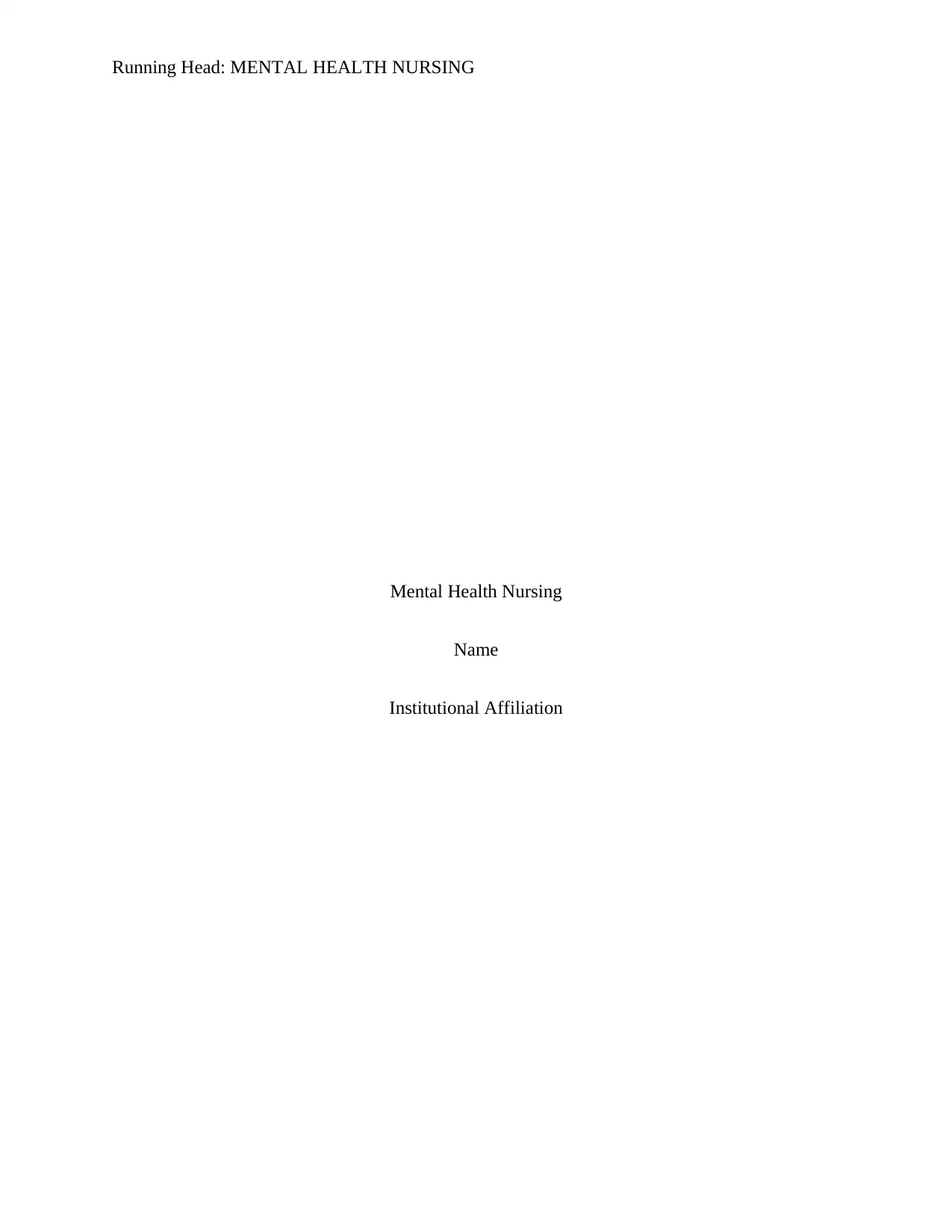
Running Head: MENTAL HEALTH NURSING
Mental Health Nursing
Name
Institutional Affiliation
Mental Health Nursing
Name
Institutional Affiliation
Paraphrase This Document
Need a fresh take? Get an instant paraphrase of this document with our AI Paraphraser
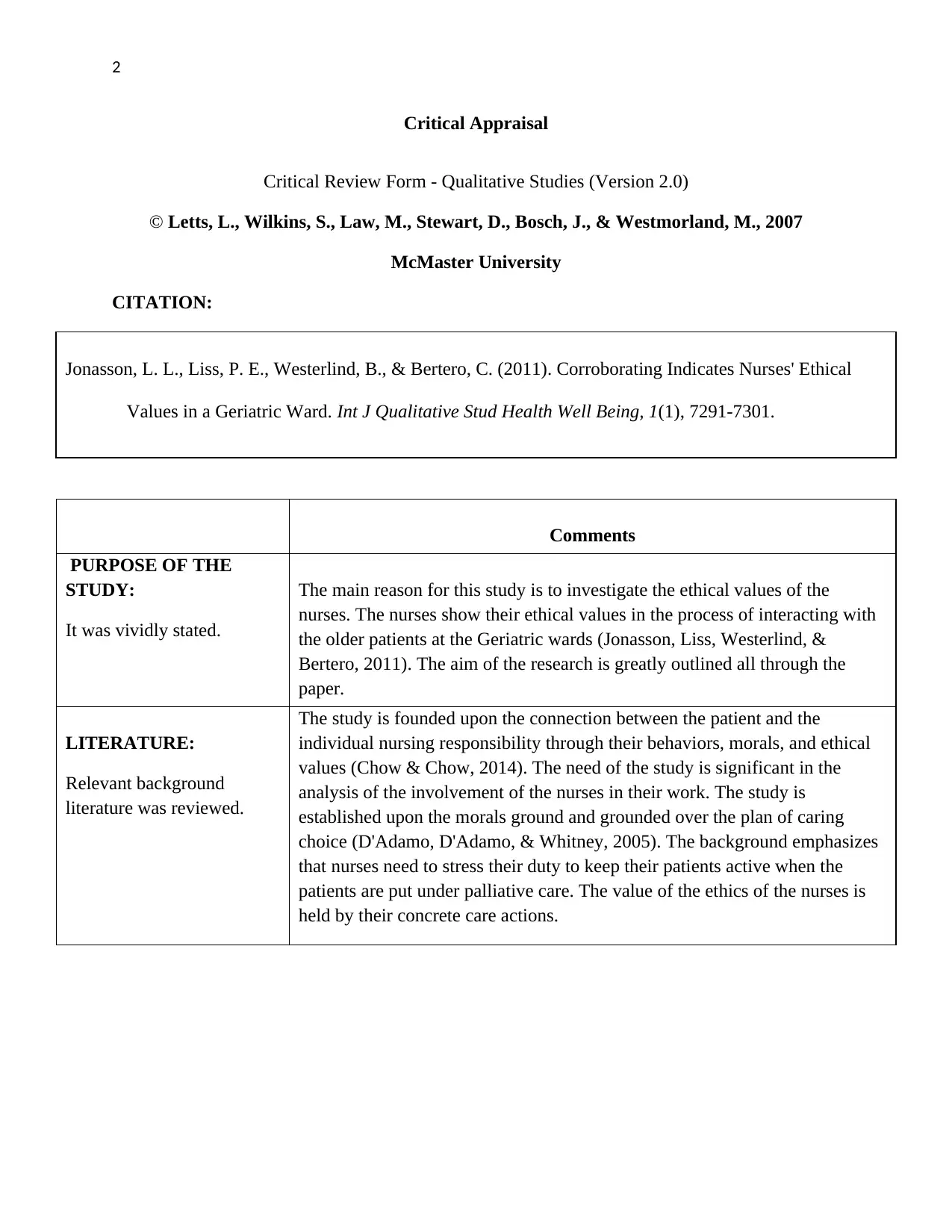
2
Critical Appraisal
Critical Review Form - Qualitative Studies (Version 2.0)
© Letts, L., Wilkins, S., Law, M., Stewart, D., Bosch, J., & Westmorland, M., 2007
McMaster University
CITATION:
Jonasson, L. L., Liss, P. E., Westerlind, B., & Bertero, C. (2011). Corroborating Indicates Nurses' Ethical
Values in a Geriatric Ward. Int J Qualitative Stud Health Well Being, 1(1), 7291-7301.
Comments
PURPOSE OF THE
STUDY:
It was vividly stated.
The main reason for this study is to investigate the ethical values of the
nurses. The nurses show their ethical values in the process of interacting with
the older patients at the Geriatric wards (Jonasson, Liss, Westerlind, &
Bertero, 2011). The aim of the research is greatly outlined all through the
paper.
LITERATURE:
Relevant background
literature was reviewed.
The study is founded upon the connection between the patient and the
individual nursing responsibility through their behaviors, morals, and ethical
values (Chow & Chow, 2014). The need of the study is significant in the
analysis of the involvement of the nurses in their work. The study is
established upon the morals ground and grounded over the plan of caring
choice (D'Adamo, D'Adamo, & Whitney, 2005). The background emphasizes
that nurses need to stress their duty to keep their patients active when the
patients are put under palliative care. The value of the ethics of the nurses is
held by their concrete care actions.
Critical Appraisal
Critical Review Form - Qualitative Studies (Version 2.0)
© Letts, L., Wilkins, S., Law, M., Stewart, D., Bosch, J., & Westmorland, M., 2007
McMaster University
CITATION:
Jonasson, L. L., Liss, P. E., Westerlind, B., & Bertero, C. (2011). Corroborating Indicates Nurses' Ethical
Values in a Geriatric Ward. Int J Qualitative Stud Health Well Being, 1(1), 7291-7301.
Comments
PURPOSE OF THE
STUDY:
It was vividly stated.
The main reason for this study is to investigate the ethical values of the
nurses. The nurses show their ethical values in the process of interacting with
the older patients at the Geriatric wards (Jonasson, Liss, Westerlind, &
Bertero, 2011). The aim of the research is greatly outlined all through the
paper.
LITERATURE:
Relevant background
literature was reviewed.
The study is founded upon the connection between the patient and the
individual nursing responsibility through their behaviors, morals, and ethical
values (Chow & Chow, 2014). The need of the study is significant in the
analysis of the involvement of the nurses in their work. The study is
established upon the morals ground and grounded over the plan of caring
choice (D'Adamo, D'Adamo, & Whitney, 2005). The background emphasizes
that nurses need to stress their duty to keep their patients active when the
patients are put under palliative care. The value of the ethics of the nurses is
held by their concrete care actions.
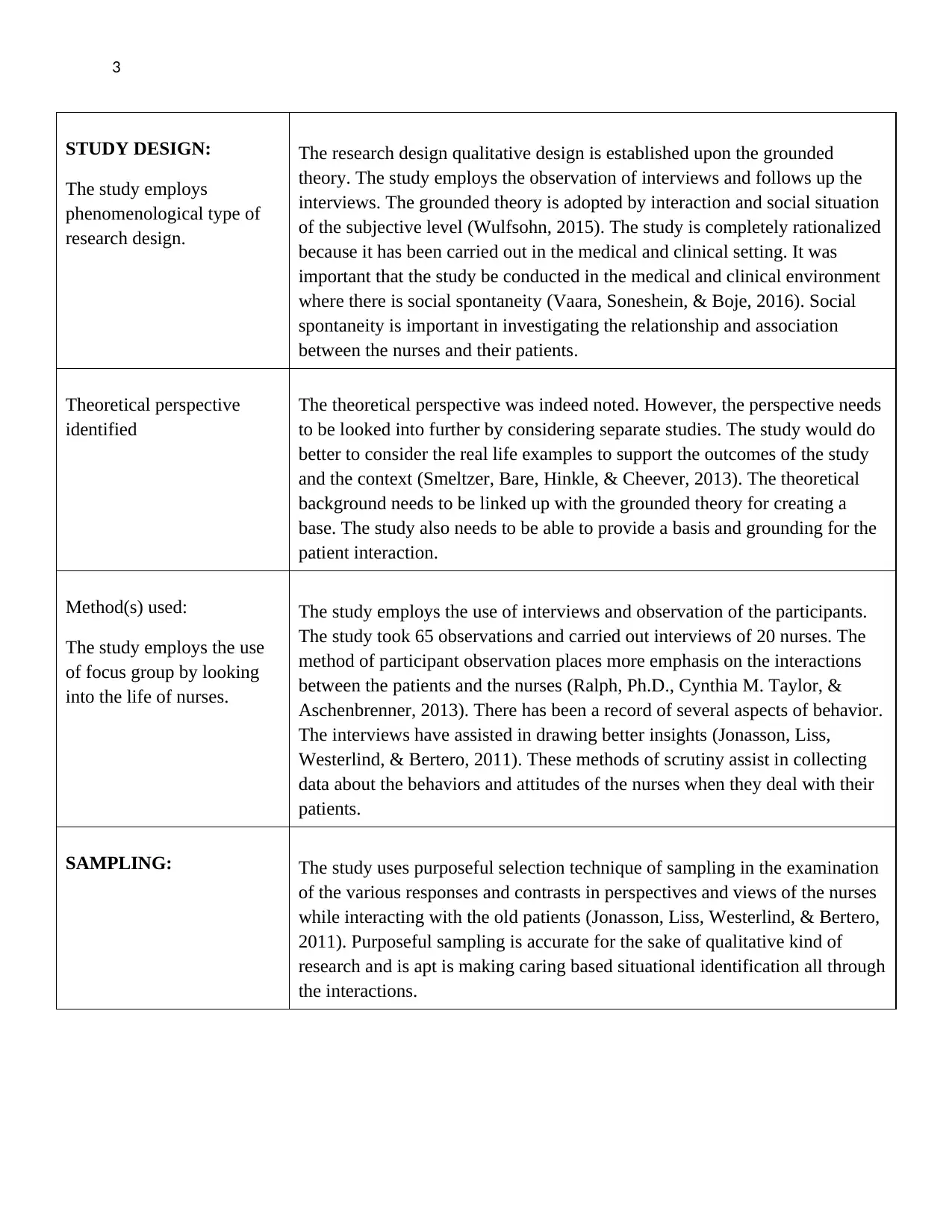
3
STUDY DESIGN:
The study employs
phenomenological type of
research design.
The research design qualitative design is established upon the grounded
theory. The study employs the observation of interviews and follows up the
interviews. The grounded theory is adopted by interaction and social situation
of the subjective level (Wulfsohn, 2015). The study is completely rationalized
because it has been carried out in the medical and clinical setting. It was
important that the study be conducted in the medical and clinical environment
where there is social spontaneity (Vaara, Soneshein, & Boje, 2016). Social
spontaneity is important in investigating the relationship and association
between the nurses and their patients.
Theoretical perspective
identified
The theoretical perspective was indeed noted. However, the perspective needs
to be looked into further by considering separate studies. The study would do
better to consider the real life examples to support the outcomes of the study
and the context (Smeltzer, Bare, Hinkle, & Cheever, 2013). The theoretical
background needs to be linked up with the grounded theory for creating a
base. The study also needs to be able to provide a basis and grounding for the
patient interaction.
Method(s) used:
The study employs the use
of focus group by looking
into the life of nurses.
The study employs the use of interviews and observation of the participants.
The study took 65 observations and carried out interviews of 20 nurses. The
method of participant observation places more emphasis on the interactions
between the patients and the nurses (Ralph, Ph.D., Cynthia M. Taylor, &
Aschenbrenner, 2013). There has been a record of several aspects of behavior.
The interviews have assisted in drawing better insights (Jonasson, Liss,
Westerlind, & Bertero, 2011). These methods of scrutiny assist in collecting
data about the behaviors and attitudes of the nurses when they deal with their
patients.
SAMPLING: The study uses purposeful selection technique of sampling in the examination
of the various responses and contrasts in perspectives and views of the nurses
while interacting with the old patients (Jonasson, Liss, Westerlind, & Bertero,
2011). Purposeful sampling is accurate for the sake of qualitative kind of
research and is apt is making caring based situational identification all through
the interactions.
STUDY DESIGN:
The study employs
phenomenological type of
research design.
The research design qualitative design is established upon the grounded
theory. The study employs the observation of interviews and follows up the
interviews. The grounded theory is adopted by interaction and social situation
of the subjective level (Wulfsohn, 2015). The study is completely rationalized
because it has been carried out in the medical and clinical setting. It was
important that the study be conducted in the medical and clinical environment
where there is social spontaneity (Vaara, Soneshein, & Boje, 2016). Social
spontaneity is important in investigating the relationship and association
between the nurses and their patients.
Theoretical perspective
identified
The theoretical perspective was indeed noted. However, the perspective needs
to be looked into further by considering separate studies. The study would do
better to consider the real life examples to support the outcomes of the study
and the context (Smeltzer, Bare, Hinkle, & Cheever, 2013). The theoretical
background needs to be linked up with the grounded theory for creating a
base. The study also needs to be able to provide a basis and grounding for the
patient interaction.
Method(s) used:
The study employs the use
of focus group by looking
into the life of nurses.
The study employs the use of interviews and observation of the participants.
The study took 65 observations and carried out interviews of 20 nurses. The
method of participant observation places more emphasis on the interactions
between the patients and the nurses (Ralph, Ph.D., Cynthia M. Taylor, &
Aschenbrenner, 2013). There has been a record of several aspects of behavior.
The interviews have assisted in drawing better insights (Jonasson, Liss,
Westerlind, & Bertero, 2011). These methods of scrutiny assist in collecting
data about the behaviors and attitudes of the nurses when they deal with their
patients.
SAMPLING: The study uses purposeful selection technique of sampling in the examination
of the various responses and contrasts in perspectives and views of the nurses
while interacting with the old patients (Jonasson, Liss, Westerlind, & Bertero,
2011). Purposeful sampling is accurate for the sake of qualitative kind of
research and is apt is making caring based situational identification all through
the interactions.
⊘ This is a preview!⊘
Do you want full access?
Subscribe today to unlock all pages.

Trusted by 1+ million students worldwide
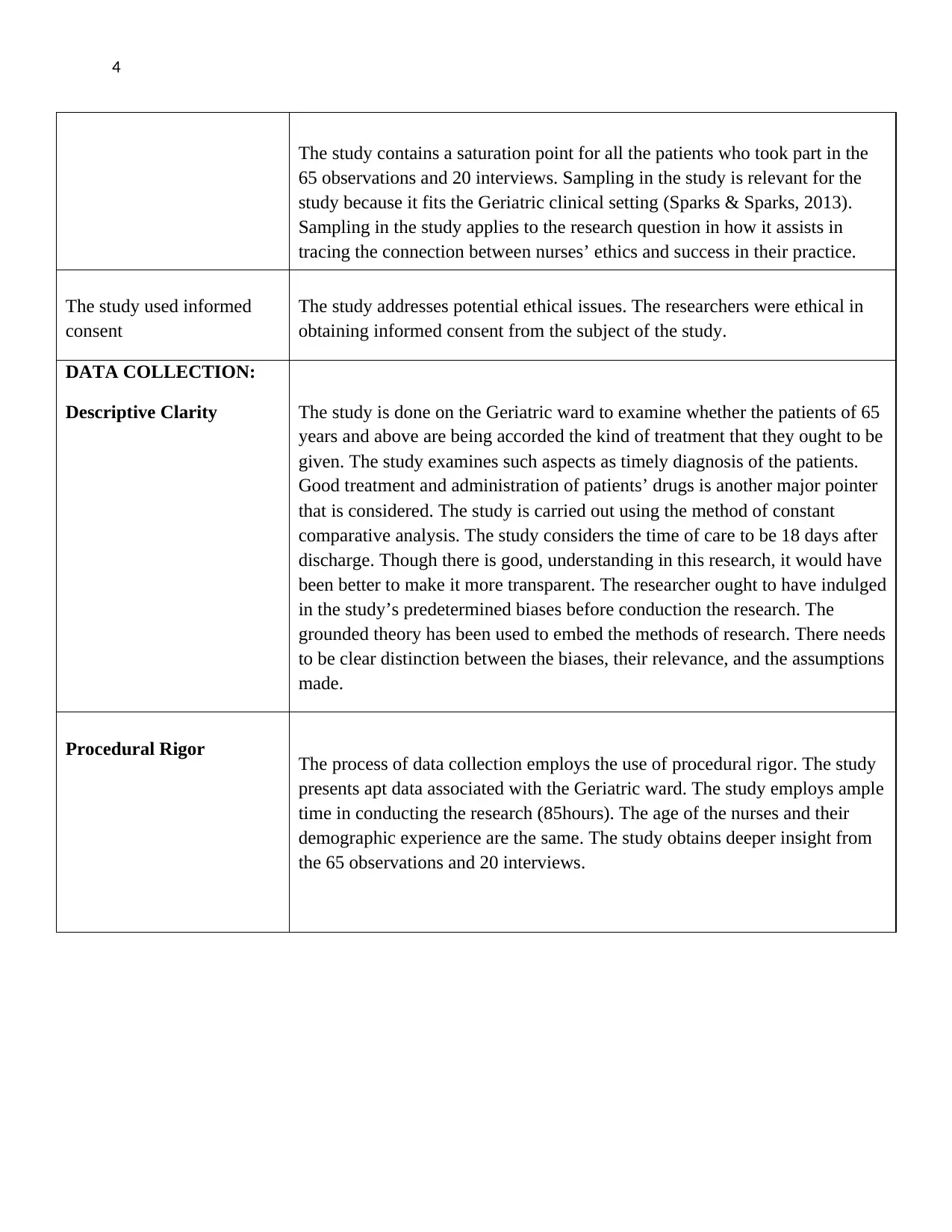
4
The study contains a saturation point for all the patients who took part in the
65 observations and 20 interviews. Sampling in the study is relevant for the
study because it fits the Geriatric clinical setting (Sparks & Sparks, 2013).
Sampling in the study applies to the research question in how it assists in
tracing the connection between nurses’ ethics and success in their practice.
The study used informed
consent
The study addresses potential ethical issues. The researchers were ethical in
obtaining informed consent from the subject of the study.
DATA COLLECTION:
Descriptive Clarity The study is done on the Geriatric ward to examine whether the patients of 65
years and above are being accorded the kind of treatment that they ought to be
given. The study examines such aspects as timely diagnosis of the patients.
Good treatment and administration of patients’ drugs is another major pointer
that is considered. The study is carried out using the method of constant
comparative analysis. The study considers the time of care to be 18 days after
discharge. Though there is good, understanding in this research, it would have
been better to make it more transparent. The researcher ought to have indulged
in the study’s predetermined biases before conduction the research. The
grounded theory has been used to embed the methods of research. There needs
to be clear distinction between the biases, their relevance, and the assumptions
made.
Procedural Rigor The process of data collection employs the use of procedural rigor. The study
presents apt data associated with the Geriatric ward. The study employs ample
time in conducting the research (85hours). The age of the nurses and their
demographic experience are the same. The study obtains deeper insight from
the 65 observations and 20 interviews.
The study contains a saturation point for all the patients who took part in the
65 observations and 20 interviews. Sampling in the study is relevant for the
study because it fits the Geriatric clinical setting (Sparks & Sparks, 2013).
Sampling in the study applies to the research question in how it assists in
tracing the connection between nurses’ ethics and success in their practice.
The study used informed
consent
The study addresses potential ethical issues. The researchers were ethical in
obtaining informed consent from the subject of the study.
DATA COLLECTION:
Descriptive Clarity The study is done on the Geriatric ward to examine whether the patients of 65
years and above are being accorded the kind of treatment that they ought to be
given. The study examines such aspects as timely diagnosis of the patients.
Good treatment and administration of patients’ drugs is another major pointer
that is considered. The study is carried out using the method of constant
comparative analysis. The study considers the time of care to be 18 days after
discharge. Though there is good, understanding in this research, it would have
been better to make it more transparent. The researcher ought to have indulged
in the study’s predetermined biases before conduction the research. The
grounded theory has been used to embed the methods of research. There needs
to be clear distinction between the biases, their relevance, and the assumptions
made.
Procedural Rigor The process of data collection employs the use of procedural rigor. The study
presents apt data associated with the Geriatric ward. The study employs ample
time in conducting the research (85hours). The age of the nurses and their
demographic experience are the same. The study obtains deeper insight from
the 65 observations and 20 interviews.
Paraphrase This Document
Need a fresh take? Get an instant paraphrase of this document with our AI Paraphraser
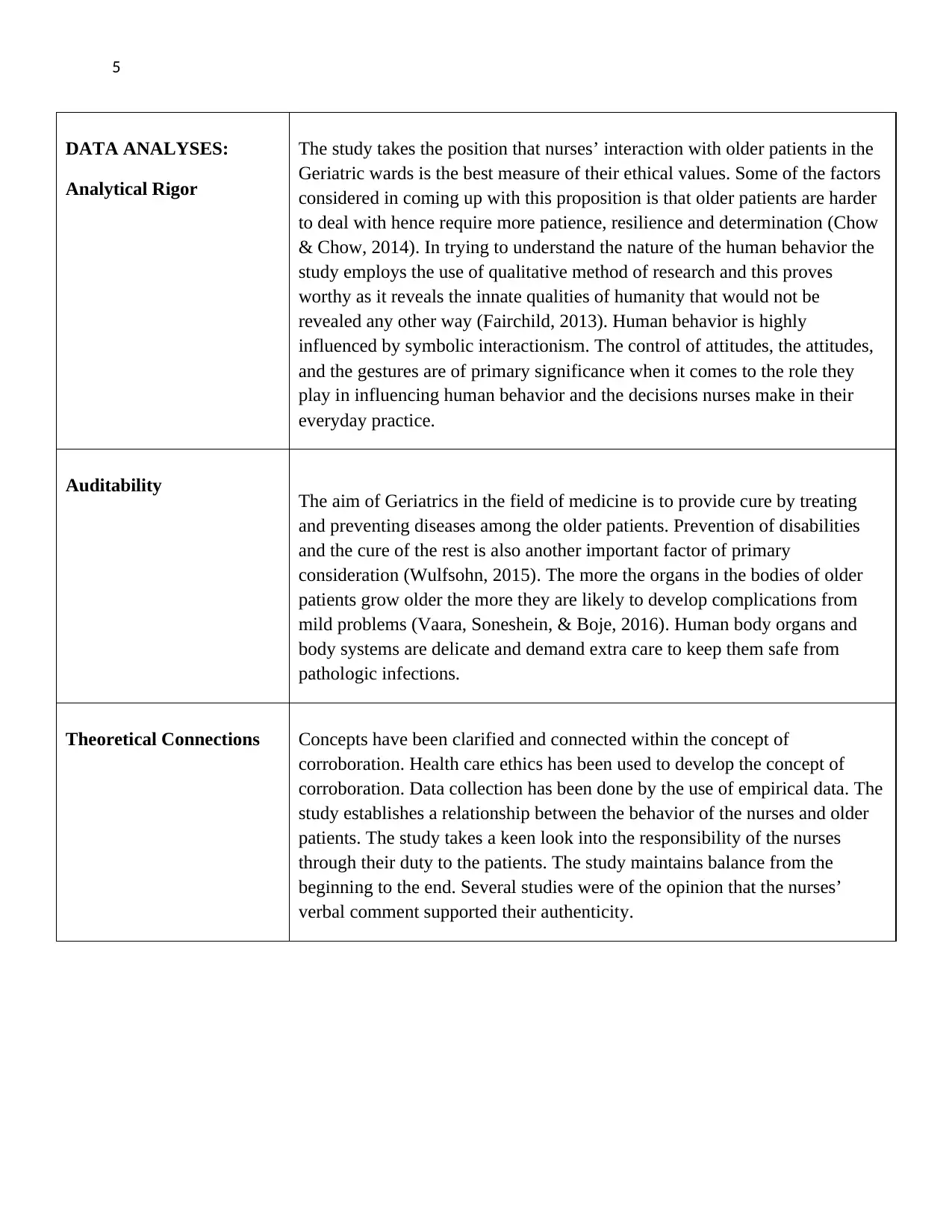
5
DATA ANALYSES:
Analytical Rigor
The study takes the position that nurses’ interaction with older patients in the
Geriatric wards is the best measure of their ethical values. Some of the factors
considered in coming up with this proposition is that older patients are harder
to deal with hence require more patience, resilience and determination (Chow
& Chow, 2014). In trying to understand the nature of the human behavior the
study employs the use of qualitative method of research and this proves
worthy as it reveals the innate qualities of humanity that would not be
revealed any other way (Fairchild, 2013). Human behavior is highly
influenced by symbolic interactionism. The control of attitudes, the attitudes,
and the gestures are of primary significance when it comes to the role they
play in influencing human behavior and the decisions nurses make in their
everyday practice.
Auditability The aim of Geriatrics in the field of medicine is to provide cure by treating
and preventing diseases among the older patients. Prevention of disabilities
and the cure of the rest is also another important factor of primary
consideration (Wulfsohn, 2015). The more the organs in the bodies of older
patients grow older the more they are likely to develop complications from
mild problems (Vaara, Soneshein, & Boje, 2016). Human body organs and
body systems are delicate and demand extra care to keep them safe from
pathologic infections.
Theoretical Connections Concepts have been clarified and connected within the concept of
corroboration. Health care ethics has been used to develop the concept of
corroboration. Data collection has been done by the use of empirical data. The
study establishes a relationship between the behavior of the nurses and older
patients. The study takes a keen look into the responsibility of the nurses
through their duty to the patients. The study maintains balance from the
beginning to the end. Several studies were of the opinion that the nurses’
verbal comment supported their authenticity.
DATA ANALYSES:
Analytical Rigor
The study takes the position that nurses’ interaction with older patients in the
Geriatric wards is the best measure of their ethical values. Some of the factors
considered in coming up with this proposition is that older patients are harder
to deal with hence require more patience, resilience and determination (Chow
& Chow, 2014). In trying to understand the nature of the human behavior the
study employs the use of qualitative method of research and this proves
worthy as it reveals the innate qualities of humanity that would not be
revealed any other way (Fairchild, 2013). Human behavior is highly
influenced by symbolic interactionism. The control of attitudes, the attitudes,
and the gestures are of primary significance when it comes to the role they
play in influencing human behavior and the decisions nurses make in their
everyday practice.
Auditability The aim of Geriatrics in the field of medicine is to provide cure by treating
and preventing diseases among the older patients. Prevention of disabilities
and the cure of the rest is also another important factor of primary
consideration (Wulfsohn, 2015). The more the organs in the bodies of older
patients grow older the more they are likely to develop complications from
mild problems (Vaara, Soneshein, & Boje, 2016). Human body organs and
body systems are delicate and demand extra care to keep them safe from
pathologic infections.
Theoretical Connections Concepts have been clarified and connected within the concept of
corroboration. Health care ethics has been used to develop the concept of
corroboration. Data collection has been done by the use of empirical data. The
study establishes a relationship between the behavior of the nurses and older
patients. The study takes a keen look into the responsibility of the nurses
through their duty to the patients. The study maintains balance from the
beginning to the end. Several studies were of the opinion that the nurses’
verbal comment supported their authenticity.
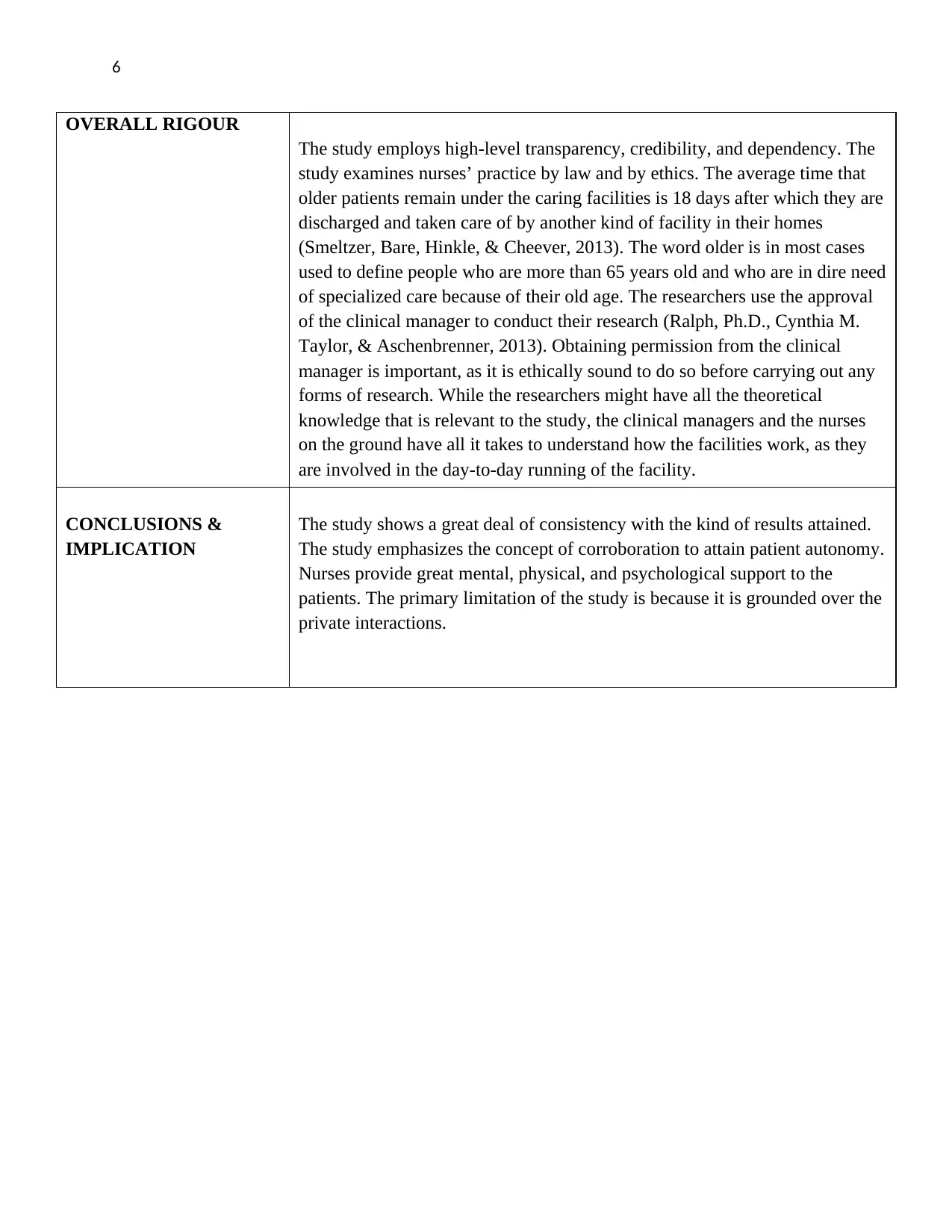
6
OVERALL RIGOUR
The study employs high-level transparency, credibility, and dependency. The
study examines nurses’ practice by law and by ethics. The average time that
older patients remain under the caring facilities is 18 days after which they are
discharged and taken care of by another kind of facility in their homes
(Smeltzer, Bare, Hinkle, & Cheever, 2013). The word older is in most cases
used to define people who are more than 65 years old and who are in dire need
of specialized care because of their old age. The researchers use the approval
of the clinical manager to conduct their research (Ralph, Ph.D., Cynthia M.
Taylor, & Aschenbrenner, 2013). Obtaining permission from the clinical
manager is important, as it is ethically sound to do so before carrying out any
forms of research. While the researchers might have all the theoretical
knowledge that is relevant to the study, the clinical managers and the nurses
on the ground have all it takes to understand how the facilities work, as they
are involved in the day-to-day running of the facility.
CONCLUSIONS &
IMPLICATION
The study shows a great deal of consistency with the kind of results attained.
The study emphasizes the concept of corroboration to attain patient autonomy.
Nurses provide great mental, physical, and psychological support to the
patients. The primary limitation of the study is because it is grounded over the
private interactions.
OVERALL RIGOUR
The study employs high-level transparency, credibility, and dependency. The
study examines nurses’ practice by law and by ethics. The average time that
older patients remain under the caring facilities is 18 days after which they are
discharged and taken care of by another kind of facility in their homes
(Smeltzer, Bare, Hinkle, & Cheever, 2013). The word older is in most cases
used to define people who are more than 65 years old and who are in dire need
of specialized care because of their old age. The researchers use the approval
of the clinical manager to conduct their research (Ralph, Ph.D., Cynthia M.
Taylor, & Aschenbrenner, 2013). Obtaining permission from the clinical
manager is important, as it is ethically sound to do so before carrying out any
forms of research. While the researchers might have all the theoretical
knowledge that is relevant to the study, the clinical managers and the nurses
on the ground have all it takes to understand how the facilities work, as they
are involved in the day-to-day running of the facility.
CONCLUSIONS &
IMPLICATION
The study shows a great deal of consistency with the kind of results attained.
The study emphasizes the concept of corroboration to attain patient autonomy.
Nurses provide great mental, physical, and psychological support to the
patients. The primary limitation of the study is because it is grounded over the
private interactions.
⊘ This is a preview!⊘
Do you want full access?
Subscribe today to unlock all pages.

Trusted by 1+ million students worldwide
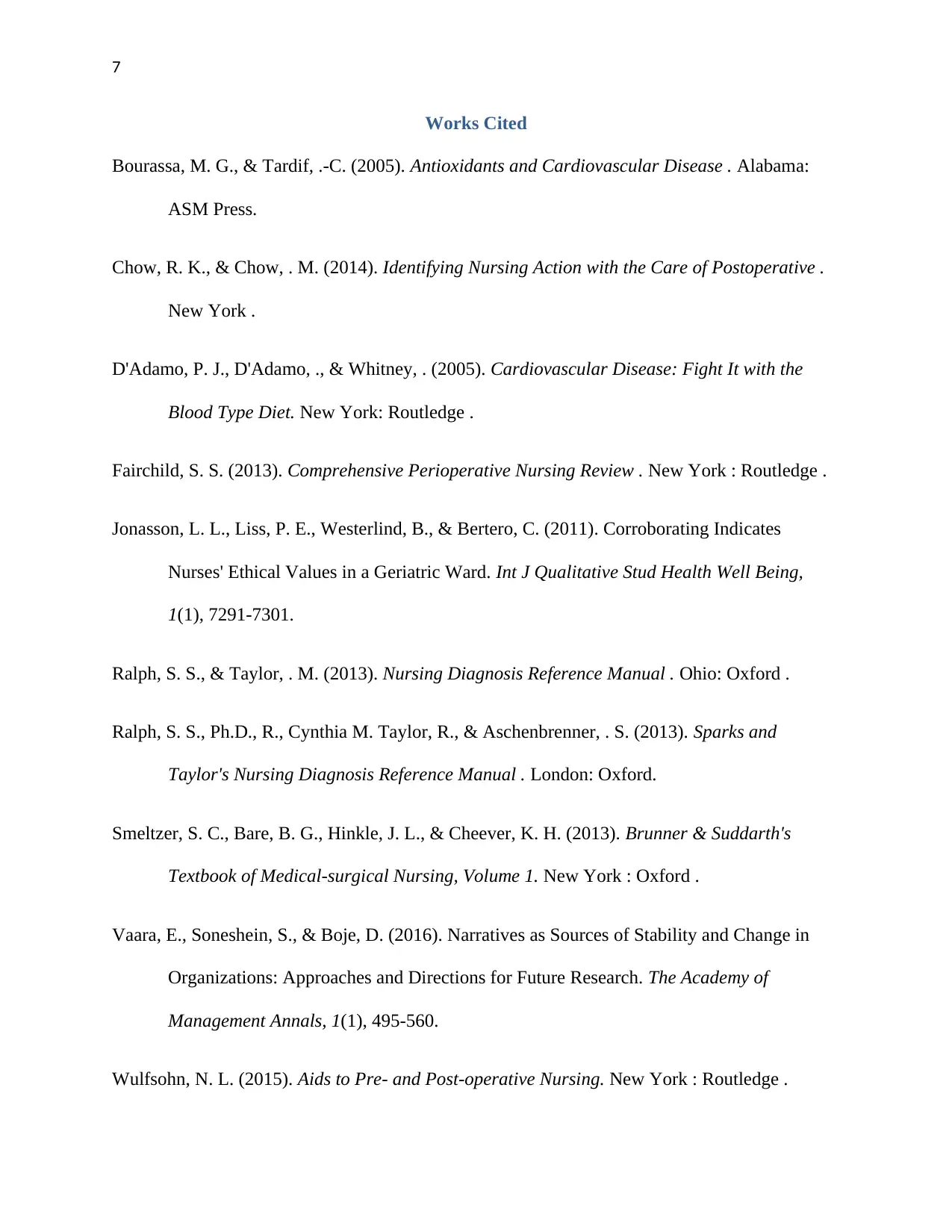
7
Works Cited
Bourassa, M. G., & Tardif, .-C. (2005). Antioxidants and Cardiovascular Disease . Alabama:
ASM Press.
Chow, R. K., & Chow, . M. (2014). Identifying Nursing Action with the Care of Postoperative .
New York .
D'Adamo, P. J., D'Adamo, ., & Whitney, . (2005). Cardiovascular Disease: Fight It with the
Blood Type Diet. New York: Routledge .
Fairchild, S. S. (2013). Comprehensive Perioperative Nursing Review . New York : Routledge .
Jonasson, L. L., Liss, P. E., Westerlind, B., & Bertero, C. (2011). Corroborating Indicates
Nurses' Ethical Values in a Geriatric Ward. Int J Qualitative Stud Health Well Being,
1(1), 7291-7301.
Ralph, S. S., & Taylor, . M. (2013). Nursing Diagnosis Reference Manual . Ohio: Oxford .
Ralph, S. S., Ph.D., R., Cynthia M. Taylor, R., & Aschenbrenner, . S. (2013). Sparks and
Taylor's Nursing Diagnosis Reference Manual . London: Oxford.
Smeltzer, S. C., Bare, B. G., Hinkle, J. L., & Cheever, K. H. (2013). Brunner & Suddarth's
Textbook of Medical-surgical Nursing, Volume 1. New York : Oxford .
Vaara, E., Soneshein, S., & Boje, D. (2016). Narratives as Sources of Stability and Change in
Organizations: Approaches and Directions for Future Research. The Academy of
Management Annals, 1(1), 495-560.
Wulfsohn, N. L. (2015). Aids to Pre- and Post-operative Nursing. New York : Routledge .
Works Cited
Bourassa, M. G., & Tardif, .-C. (2005). Antioxidants and Cardiovascular Disease . Alabama:
ASM Press.
Chow, R. K., & Chow, . M. (2014). Identifying Nursing Action with the Care of Postoperative .
New York .
D'Adamo, P. J., D'Adamo, ., & Whitney, . (2005). Cardiovascular Disease: Fight It with the
Blood Type Diet. New York: Routledge .
Fairchild, S. S. (2013). Comprehensive Perioperative Nursing Review . New York : Routledge .
Jonasson, L. L., Liss, P. E., Westerlind, B., & Bertero, C. (2011). Corroborating Indicates
Nurses' Ethical Values in a Geriatric Ward. Int J Qualitative Stud Health Well Being,
1(1), 7291-7301.
Ralph, S. S., & Taylor, . M. (2013). Nursing Diagnosis Reference Manual . Ohio: Oxford .
Ralph, S. S., Ph.D., R., Cynthia M. Taylor, R., & Aschenbrenner, . S. (2013). Sparks and
Taylor's Nursing Diagnosis Reference Manual . London: Oxford.
Smeltzer, S. C., Bare, B. G., Hinkle, J. L., & Cheever, K. H. (2013). Brunner & Suddarth's
Textbook of Medical-surgical Nursing, Volume 1. New York : Oxford .
Vaara, E., Soneshein, S., & Boje, D. (2016). Narratives as Sources of Stability and Change in
Organizations: Approaches and Directions for Future Research. The Academy of
Management Annals, 1(1), 495-560.
Wulfsohn, N. L. (2015). Aids to Pre- and Post-operative Nursing. New York : Routledge .
1 out of 7
Related Documents
Your All-in-One AI-Powered Toolkit for Academic Success.
+13062052269
info@desklib.com
Available 24*7 on WhatsApp / Email
![[object Object]](/_next/static/media/star-bottom.7253800d.svg)
Unlock your academic potential
Copyright © 2020–2025 A2Z Services. All Rights Reserved. Developed and managed by ZUCOL.





